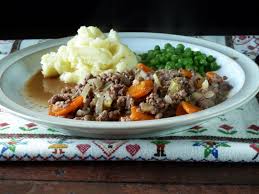A short treatise on the different forms of mince. But first I wanted to say that with this strange weather we are currently experiencing in Moscow - rapid temperature drops followed by rapid rises followed by rapid drops the landscape can change several times in one day: lovely pristine white snow can quickly melt and change into giant puddles and then the temperature suddenly drops again and parts of Moscow turn into an ice rink.
The ice reminds me that it is the time of the year to start mincing again! We use the word to mean walking 'gingerly' but it has another meaning too ((of a man) affectedly dainty in manner or gait; effeminate:) If you don't tread carefully you could easily slip on the ice and there are no local councils here willing to shell out megabucks in compensation for one's lack of attention. Easy to fall head over heels or, for the less sophisticated of my readers, A over T. (No explanations - if you don't know it, you don't know it!)
Back to the mince. Mince pies are enjoyed all year round in UK, but particularly over Christmas.

They are not made out of mince (фарш) but out of mincemeat (chiefly British a mixture of currants, raisins, sugar, apples, candied peel, spices, and suet, typically baked in pastry:) (начинка для пирога из изюма, яблок, миндаля, сахара, цукатов и пр.). Mincemeat doesn't have any meat in it, not these days anyway, but will often have alcohol - especially brandy.
Mince is minced meat and often used on it's own as mince and potatoes:

or perhaps in a shepherd's pie (minced lamb) or cottage pie (minced beef) (both known in Russian as запеканка):

or, my own favourite, in a spicy chilli con carne:

Enjoy!
The ice reminds me that it is the time of the year to start mincing again! We use the word to mean walking 'gingerly' but it has another meaning too ((of a man) affectedly dainty in manner or gait; effeminate:) If you don't tread carefully you could easily slip on the ice and there are no local councils here willing to shell out megabucks in compensation for one's lack of attention. Easy to fall head over heels or, for the less sophisticated of my readers, A over T. (No explanations - if you don't know it, you don't know it!)
Back to the mince. Mince pies are enjoyed all year round in UK, but particularly over Christmas.
They are not made out of mince (фарш) but out of mincemeat (chiefly British a mixture of currants, raisins, sugar, apples, candied peel, spices, and suet, typically baked in pastry:) (начинка для пирога из изюма, яблок, миндаля, сахара, цукатов и пр.). Mincemeat doesn't have any meat in it, not these days anyway, but will often have alcohol - especially brandy.
Mince is minced meat and often used on it's own as mince and potatoes:
or perhaps in a shepherd's pie (minced lamb) or cottage pie (minced beef) (both known in Russian as запеканка):
or, my own favourite, in a spicy chilli con carne:
Enjoy!

No comments:
Post a Comment